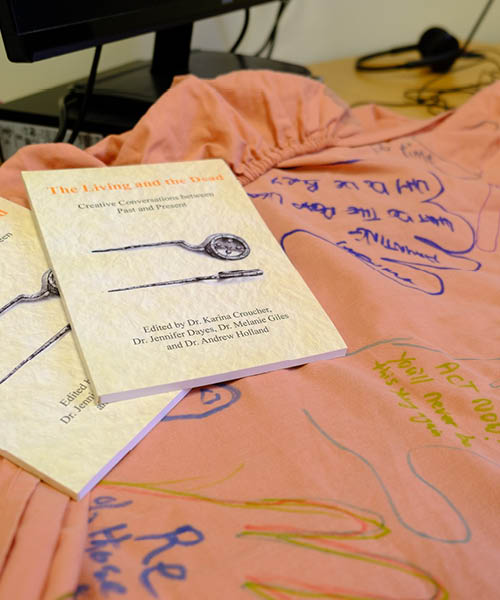As an example of challenging orthodoxies and in demonstrating the explicit link between the past, the present and indeed the future, the Continuing Bonds project is a unique exemplar of archaeology’s value, with testimony from participants evidencing profound impact on personal and professional growth.
Continuing Bonds: exploring the meaning and legacy of death through past and contemporary practice is an Arts and Humanities Research Council (AHRC)-funded collaboration between the University’s archaeologists, health care/ nursing and psychologists to use archaeology as a positive medium to enable productive conversations about death, dying, loss and bereavement, subjects that many find difficult to talk about.
While death and grieving are difficult topics, open discussion can build resilience and enable planning and more positive experiences. The pandemic has provided a timely and heightened context to such issues. Working with the LOROS Hospice in Leicester, the project provided an alternative framework for reflecting on death, through accessible archaeological case studies that revealed the variety of methods by which past societies have dealt with death and the dead. It focused on an enduring concept: that of ‘continuing bonds’ with the dead, which recognises that death is not the end of relationships between the living and the dead, but that the dead continue to have meaning and significance in the lives of the living.
Participants in the project included representatives from health and social care, counselling, funerary services, faith leadership, charitable volunteering, educators and students. Workshops were held exploring the diversity of rituals, beliefs and practices around death and loss, including discussion around archaeological artefacts that illustrated both differences and similarities in belief and perception.
These discussions enabled participants to appreciate and understand different concepts of death and the values attached and prompted questioning and reappraisal of their own held beliefs, attitudes and biases. More than 90 per cent of participants reported that the discussions prompted open and effective conversations that previously they would have had difficulty with and helped them to articulate thoughts and feelings in a new way.
Participants also reported personal growth and development as a result of taking part in the workshops, and in many cases this has led to improved professional practice, even among experienced health and social care practitioners, such as an improved confidence and ability to empathise with clients.
The Continuing Bonds team has used this impact to create an online resource for continuing professional development for counsellors, which uses archaeological and contemporary examples to explore death and grief.
Workshop participants’ testimonies include:
Attending the Continuing Bonds: Creative Dissemination project gave me the encouragement to talk to people about grief, both my own, and to open up conversations with other people, such as work colleagues who mentioned that they had lost people. Listening to their testimonies validated my own experiences and that helped me process my grief.
Last year and this year have been the first years in decades that I have not lived with profound grief...I attribute that to the workshops giving me the space to talk about my losses.
In my work at inquests, I feel more confident sharing my own experiences of bereavement with the families, and there are many situations where this has really helped the family get through a really difficult day.
My confidence has grown since attending the workshop, I have worked since that time with many more clients. A part of the growth in confidence is that I feel more touched as a human and aware of being a human, and somehow this makes me braver. I have an enriched sense of connection with others.
Without a shadow of doubt, involvement in the project has been life changing… this has been hugely influential on my life.
A further development of this work has been a collaborative project with young people, Child Bereavement UK, Bradford Bereavement Support and a partner UK university called Dying To Talk. The project co-created resources with young people, for young people, including making a film showcased at a ‘festival of the dead’ for school pupils, held at the University.
In the unscripted film, young people spoke about their personal experiences of the progression from talking about archaeology through to having conversations today, discussing their personal reflections, even going on to deliver practical advice about dealing with death and bereavement, including good conversation starters.
The AHRC-funded Continuing Bonds: Creative Dissemination project used archaeology and original Continuing Bonds experiences to normalise talk of the dead and inspire creative writing, through workshops with members of the public in Bradford, Manchester and Sheffield, culminating in an anthology and celebration events where participants read their work to friends, families and stakeholders.
Since the poem was created I’ve enjoyed reading it in public many times, and having the support of C.Bonds has meant that since publishing the piece I’ve been able to feel proud and honoured to be part of something that will have a lasting legacy and influence in the community.
Participant, Continuing Bonds: Creative Dissemination workshop
The impact that the project has had in linking archaeology with end-of-life care has been recognised, with members of the team being invited to speak at the annual conference of the Association of Palliative Care Services, the bi-annual Palliative Care Congress and to address Bradford’s Managed Clinical Work Forum.

